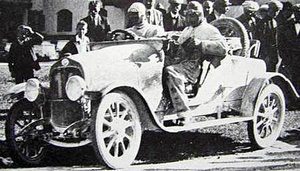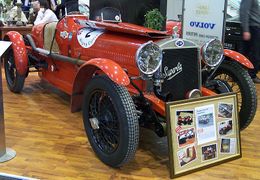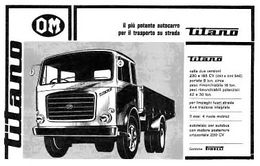Officine Meccaniche

Officine Meccaniche (OM) was an Italian car and truck manufacturing company, founded in 1899 in Milan as Societa Anonima Officine Meccaniche. SA Officine Meccaniche had a long tradition of transport manufacture, having built carriages from the mid-nineteenth century and locomotives from 1889. Their motor manufacture dated to 1917 when they took over Fabbrica Automobili Züst, and their first cars were much like the Züst S305, badged with the initials O.M. The first completely new design was the Tipo 465 of 1921, so designated from its four cylinders of 65mm bore. Designed by Austrian-born engineer Barratouché, it was a monobloc sidevalve engine of advanced design. Cooling was by thermosyphon, but the engine boasted a water-cooled centre main bearing and 12-volt Bosch coil ignition. The four-speed gearbox had a centre ball change and a single plate dry clutch was used. Four-wheel cable-operated drum brakes were available and centre-lock wire wheels were the usual fitment.
The inception of the company had resulted from the merger of two companies,Grondona Comi & C and Miani Silvestri & C. Originally, OM manufactured railway stock. Car production started in 1918, using the plant of the former Brixia-Zust (Brixia-Züst), just after OM took over Zust car company of Brescia, Northern Italy.
The first OM car, Tipo S305, primarily an old Zust model, appeared in 1918 with a 4712cc four-cylinder side-valve in-line engine.
Further models were Tipo 465 (with a 1327cc four) in 1919, Tipo 467 (1410cc) and Tipo 469 (1496cc) in 1921. 1923 saw an all new model, Tipo 665 'Superba' with a 2-litre six-cylinder engine. This model was extremely successful in racing - won top five positions in 1925 and 1926 at Le Mans but the grestest achievement was the victory in the first Mille Miglia race in 1927 winning the first three positions. Some cars were equipped with Roots superchargers.
15/45hp, 1,990 cc side-valve six-cylinder engine, four-speed manual gearbox, solid front axle and live rear axle with semi-elliptic leaf springs, four-wheel mechanical brakes. Wheelbase: 122" (3,100mm)
With an increase in bore, the 465 became the 467, and, with a further enlargement in 1923, Tipo 469. Various competitors had made a name for the cars, winning the 1920 Coppa de Garda and dominating their class in the 1922 event, and finishing second in the 1921 Circuito di Brescia. In 1923, Masperi won his class at the Cremona circuit, wresting laurels from a Chiribiri and a Bugatti. International recognition came later, with a victory in the 1925 Tripoli Grand Prix, followed by success in Spain and a fourth-place tie for the two-car team at Le Mans. The inaugural Mille Miglia in 1927 was a 1-2-3 sweep for O.M.
In 1923 O.M. introduced their first six. A straightforward extension of the 465 engine, it was designated, logically, Tipo 665. Late in 1924 came a twin-carburetor version, which required a new block casting since the manifold was internal. Two centre mains were utilized, water-cooled in the manner of the 465. Like the four-cylinder before it, the 665 grew into the 667 with larger bore and more power. A few cars were supercharged for competition use by works teams.
The O.M. developed a certain vogue in England during the mid-1920s. The 665 in particular was quite popular, frequently fitted with bodies by the local coachbuilders. The London concessionaire, L.C. Rawlence, engaged R.F. Oats to further develop the model, and Ricardo-type overhead valve conversions and stronger drivetrains were the result, though only for British consumption.
O.M. was purchased by Fiat in 1933, and passenger car production was halted the following year. However, O.M.-badged commercial and military vehicles were built until the late 1960s.Source
OM was taken over by the Fiat Group in 1933 and in the following year, passenger car production ceased. OM became a commercial vehicle manufacturer.
In 1975 OM was absorbed (as part of the Fiat Group) into IVECO.
Detailed Timeline
Founded in 1899 in Milan, as a result of the merger of "Grondona Com & C" and "Miani Silvestri & C," OM "Società Anonima Officine Meccaniche" manufactured materials rail and other heavy engineering products. On October 1, 1917 OM took over the automaker Züst, thus obtaining a car factory in Brescia, northern Italy.
The first model of OM, the Model S305, appeared in 1918, equipped with a 4-cylinder engine with 4712cc and lateral valves and an output of 30hp. It was basically an old model Züst.
In 1919, was a completely new car, the Type 465. Was equipped with a 4-cylinder engine and 1327cc. This model was produced for the most part with a body of 4-type torpedo, which had a great reception from the public, and that many units were sold for the season.
The engine of this model was enhanced gradually, first to 1410cc for the Type 467 of 1921 and later to 1496cc for the Type 469. These two models were also constructed in sports versions.
In 1923, appeared a new model, the Type 665 "Superba" with a new 6-cylinder engine and 2 liters. This model greatly enhanced the prestige of the Company, aided also by their significant sporting successes and obtaining alguinos world records at the time.
Notable were her 5 top positions at [Le Mans] in the years 1925 and 1926 and victory in the 1927 Mille Miglia, where OM Superba occupied the top three positions.
The engine of the Superba was gradually developed and improved, increasing its power to 2.2 liters in 1930.
In 1933 the production facilities of cars were absorbed by the Fiat group.
In 1934 they was presented a new model, the Type V, with a 6-cylinder engine and 2130cc, but failed to be produced in batches.
In 1937, unifying the OM plants in Brescia and Milan. This creates three sectors: buses and trucks, railway equipment, agricultural tractors, forklifts and marine engines, motor pumps and refrigeration systems. All this as part of the Fiat Group.
In 1951 the first OM manufactures forklift equipped with internal combustion engine.
In 1956 OM begins to market its products through Care & Subsidiaries, including overseas.
In 1961 the "Piccola Industry Meccanica sul Po" (PIMESPO), a manufacturer of storage trucks, began in Luzzara (RE).
In 1967 OM falls within the FIAT group and is consumed as an integral part of Veicoli Industriali.
In 1970 establishing the plant in Bari, which in turn will be expanded in 1977.
In 1975, OM is transformed into "FIAT Carrelli ELEVATORI", a division of the Iveco group.
In 1981 IVECO purchases the current production plant in Luzzara.
In 1992, the Linde Group acquires a share of FIAT company "Carrelli ELEVATORI."
In 2000, the headquarters of the company is moved from the old building on Via Pompeo Leoni in Milan to the new headquarters in Lainate.
In 2001 the plant in Bari carried out various structural changes, including the construction of new assembly lines for trucks and a new painting system.
Since Nov. 1, 2002, the company changed its corporate name to "OM Carrelli ELEVATORI SpA" and the name FIAT will disappear from the corporate name.
In 2006 the 3 brands Linde, STILL and OM unite under the name of the Kion Group.
Gallery
External Links
| Car Information and Photos by Marque: A - B - C - D - E - F - G - H - I - J - K - L - M - N - O - P - Q - R - S - T - U - V - W - X - Y - Z |
| Motorcycle Information and Photos by Marque: A - B - C - D - E - F - G - H - I - J - K - L - M - N - O - P - Q - R - S - T - U - V - W - X - Y - Z |







